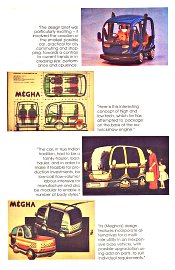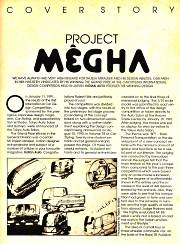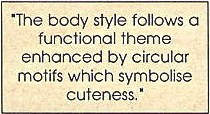 |
PRESS
PRESS
|
|
 March 1991
Features Project MÊGHA On January 11, 1991, the results of the first International Car Design Competition, sponsored by the prestigious Japanese design magazine, Car Styling, and supported by San'ei Shobo, Tokyo Auto Salon and lzumiya, were announced at the Tokyo Auto Salon. The Grand Prize Winner in the General Division was a certain Mr Rajesh Mirajker, Indian designer extraordinaire and subject of a number of articles in your favourite magazine, Indian Auto. Congratulations Rajesh! We are justifiably proud of you!
The theme was 'BPT - Basic Personal Transportation' or the development of a new concept vehicle with the minimum amount of space and functions to be a useful part of our lifestyle. The judging was conducted by five judges and all the judges felt that the main feature of this year's competition, compared to the past three competitions which were based only on scale model submission, was the degree of craftsmanship shown in the entries and the increase in the level of skill demonstrated by the entrants. Also, they were able to see that this competition had grown in form and content due to the increase in number and the high quality of entries from abroad. Judge Hoshino said: "We highly evaluated Mr Mirajker's entry as it is based on and has roots in the Indian environment and lifestyle." The idea of a small four or three-wheeler commuter car, on the basis of the Bajaj RE Autorickshaw, has crossed many minds, including that of Rajesh Mirajker. He found the design brief for the competition particularly exciting - it involved the creation of the smallest possible car, practical for city commuting and shopping, towards a contrast to current trends in increasing size, performance, and opulence of products presented by auto makers around the world. The contest was, in essence, aimed at generating innovations for down-sized and economical basic personal transport in the face of various modern concerns and associated awareness movements. The Gulf crisis was yet to emerge, then.
Megha was conceived as a four-wheeler due to the fait accompli of three-wheelers being regarded in the generic category of 'auto'. Given the lowly stature of autorickshaws in our cities, it is not acceptable to our status-conscious society as being a thorough car. Similarly, in most parts of the developed world, vehicles with less than four wheels are perceived as ‘recreation vehicles.’ Participation in a design competition is a rich experience for every designer, and Rajesh approached the competition with the view towards practical learning. Such competitions also serve as a cultural exchange, by bringing together people from such diverse backgrounds and experiences, to approach situations that have a global relevance. The initial phase of the event required the submission of detailed design work on paper. As is usual for most Indians, Rajesh was at a disadvantage due to the unavailability of sophisticated professional art equipment. And it was greatly encouraging for him to learn that he had been placed second in the initial evaluation. Fate dictated the disqualification of the entrant who was placed first in the preliminary round. Building the scale model to high-quality standards, for the second stage of the competition, was the next major hurdle. Car models are conventionally made of industrial clay, which is a quick and forgiving medium, to make solid block models, which are then painted and finished to a high degree, with surface graphics. The lack of availability of the material and requisite tools made Rajesh plan a more elaborate model of thermoplastic, showing the interior, door-opening feature and steering front axles to add poise and realism to the model. The experiences were many - from the collection of sponsorship towards the high cost of the model, to fabricating and assembling the model, much like an actual car would be assembled, to making arrangements for its export to the motor show and the re-import of the model, in view of the time restrictions. Here, he feels extremely obliged to mention the firm support given him by his parents, the encouragement of his sponsor and his friends who helped him through some difficult situations. The model and drawings of Megha were exhibited at the Tokyo Auto Salon in January 1991. Rajesh Mirajker would like to see Megha go much further than she was originally intended, particularly due to the necessity of such transport, today, in India and abroad. The car has attracted a lot of attention and enthusiasm from those who have seen the concept - especially amongst the fairer sex - and is viewed by many as an ideal second car. In the meantime, there is much he plans to do to improve on the various features of Megha, and he hopes that cars like Megha will, one day, be accessible to Indian drivers. BOX ITEM IN ARTICLE Megha means light clouds in Hindi. The name denotes a feeling of lightness and an expression of freedom. Megha is planned on the mechanicals and format of the Bajaj RE three-wheeler. Its design features incorporate alternatives for a multi-role utility in an inexpensive base vehicle, with possible upgradation using add-on parts, to suit individual requirements. Megha covers a very small floor area and seats four passengers in a spartan single volume body. The driver and front passenger sit in a cab-forward layout over the front wheels for effective front-to-back space utilisation. The rear doors are larger, and the rear seat is removable, to enable shopping and odd-job micro van applications.
The semi-open body has swing-up door bars that take up no space when open, and offer wide access. Spring-loaded flexible canvas and plastic screens are rolled within the bars. Simple sealing and velcro attachment secure them to the apertures, to provide protection against the weather. The lower screens can be independently deployed when carrying children. The door bars will be less expensive compared with (the optional) conventionally hinged and sliding doors. The surrounding bumper has recessed footsteps for easy entry. The rearview mirror-signal combinations serve as clearance markers. The signals also indicate door opening, for passenger safety. The tail-lamp unit on the driver's side is detachable and can be placed outboard for hazard warning. The body shell is modular and lightweight. The rear module can be changed to make way for an alternative flat-bed pickup and features a lockable stowage in the wheelbase region. The body adapts to light plastic alloy composites moduled by processes such as SMC, SRIM, RIM, and hand-layed GRP, or can be comprised of pressed-sheet metal panels. Tooling costs for sheet metal are reduced by commonising the rear door aperture panel and also the bumper section, and body turn-unders for the left and right-hand sides below the rear door panel. The use of the windscreen as a backlight is not obvious due to different relative locations and the unique profile of the vehicle. |
|
| About us |
| Services |
| Highlights |
| Contact |
| Portfolio |
| Automotive |
| Product Design |
| Off Highway |
| Farm |
| Recreation |
| Aerospace |
| Concepts |
All rights reserved. © Mirajker Design 2003
 The competition was divided into two stages, with the results of the preliminary first stage process (a rendering of the concept based on two-dimensional submissions along with a written statement explaining the design concept) being announced on August 18, 1990, in Volume 78 of Car Styling. Twenty-nine student entrants and 24 general entrants passed this stage. Of these successful entrants, 14 student entrants and 16 general entrants proceeded on to the final three-dimensional judging. The 1/10 scale model was submitted for each entry to the office of the design competition or taken directly to the Auto Salon at the Harumi Trade Center by January 10, 1991. After judging, the model was put on display for view by visitors to the Tokyo Auto Salon.
The competition was divided into two stages, with the results of the preliminary first stage process (a rendering of the concept based on two-dimensional submissions along with a written statement explaining the design concept) being announced on August 18, 1990, in Volume 78 of Car Styling. Twenty-nine student entrants and 24 general entrants passed this stage. Of these successful entrants, 14 student entrants and 16 general entrants proceeded on to the final three-dimensional judging. The 1/10 scale model was submitted for each entry to the office of the design competition or taken directly to the Auto Salon at the Harumi Trade Center by January 10, 1991. After judging, the model was put on display for view by visitors to the Tokyo Auto Salon. This brief fitted in very well with Rajesh's perceptions of what the average middle-class of our society would aspire for and expect of a personal car - one that is within their purchasing power, that they can use cheaply, conveniently and efficiently. The car, in true Indian tradition, had to be a family-hauler, load-hauler, and in order to make it feasible for production investments, be low-cost/low-volume/labour-intensive for manufacture and also be modular to enable a number of body styles. Hence, it should be flexible for the multitude of uses that such a car would be subject to. The car also had to "in" with current design and aesthetic trends and reflect some of the body design/manufacturing technologies abroad, while also being viable for its production in India. So, here is this interesting concept of high and low tech, which he has attempted to ‘package’ on the basis of the autorickshaw engine.
This brief fitted in very well with Rajesh's perceptions of what the average middle-class of our society would aspire for and expect of a personal car - one that is within their purchasing power, that they can use cheaply, conveniently and efficiently. The car, in true Indian tradition, had to be a family-hauler, load-hauler, and in order to make it feasible for production investments, be low-cost/low-volume/labour-intensive for manufacture and also be modular to enable a number of body styles. Hence, it should be flexible for the multitude of uses that such a car would be subject to. The car also had to "in" with current design and aesthetic trends and reflect some of the body design/manufacturing technologies abroad, while also being viable for its production in India. So, here is this interesting concept of high and low tech, which he has attempted to ‘package’ on the basis of the autorickshaw engine.
 The body style follows a functional theme enhanced by circular motifs which symbolise cuteness. Transition of the rounded surfaces from the front to a 'volume' between the front and rear wheels effects a balance to the pronounced front overhang, giving an animated character. The circular perforations at the rear provide an open atmosphere for the air-cooled engine.
The body style follows a functional theme enhanced by circular motifs which symbolise cuteness. Transition of the rounded surfaces from the front to a 'volume' between the front and rear wheels effects a balance to the pronounced front overhang, giving an animated character. The circular perforations at the rear provide an open atmosphere for the air-cooled engine.